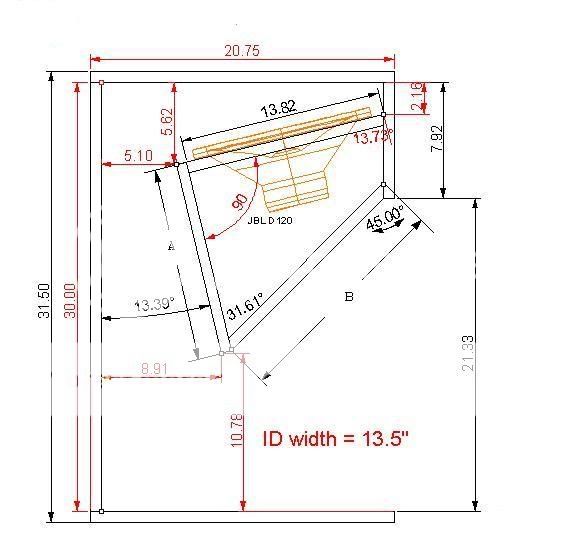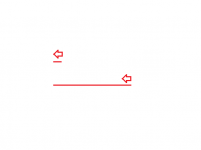The reason for folding, for me at least is time alignment. Something like this:
An externally hosted image should be here but it was not working when we last tested it.
The reason for folding, for me at least is time alignment. Something like this:
An externally hosted image should be here but it was not working when we last tested it.
That's not time aligned - you have to look at the path length down the middle 😕 of the folded horn IE the that line drawn is wrong
So it's not aprox. where the voice coils are at? As in Klipsch La Scala, woofer and midrange +- alligned, tweeter 15 inch forward misaligned?
An externally hosted image should be here but it was not working when we last tested it.
Last edited:
re:55-2952 - real parameters:
http://www.diyaudio.com/forums/subwoofers/211646-bang-buck-18-15-subs-2.html#post3067064
dunno who has real horn drivers cheap - I use 12pe32 in a little Karlson - its not cheap
Hmm...that's frustrating. How do companies get away with what's effectively false advertising?
I think I'll use one of the designs you've advertised freddi, probably the one with the Eminence Alpha 6a.
I did a quick test of the T18 sub I'd just finished last night, and the results were quite interesting. I don't have any measuring equipment, but just plugging it it to the receiver that our television runs through (and without any EQ) I was surprised to hear how much of the midrange it could re-produce. It did have horn-like characteristics in some areas though, so I'd have to be careful with the EQ, and high pass filters.
also see what jlh has used. john is pretty sharp with horns. one time he liked the fane studio 8 and beyma 8mi100.
Thanks winslow, I'll have a look into his experiences. I've seen a lot of posts from him, and his 'research' definitely shows! 🙂
So it's not aprox. where the voice coils are at? As in Klipsch La Scala, woofer and midrange +- alligned, tweeter 15 inch forward misaligned?
An externally hosted image should be here but it was not working when we last tested it.
Wikipedia's page on it seems to refer to the 'acoustic centre' of the speaker, rather than the voice coils themselves:
Wikipedia - Loudspeaker time alignment
That's not time aligned - you have to look at the path length down the middle 😕 of the folded horn IE the that line drawn is wrong
With horns, would it be that the mouths are time aligned? From what I've read, the virtual 'point source' of each horn is meant to be the horn's mouth, so as long as those are on the same plane would that time alignment be correct?
Then again, a lot of the professional horn systems I've seen (on YouTube) are physically staggered, so that theory doesn't seem to pan out.
also see what jlh has used. john is pretty sharp with horns. one time he liked the fane studio 8 and beyma 8mi100.
First, I've only skimmed this thread, but it does hold my interest. Midbass horns are the most fascinating audio dilemma, most often done poorly for size sake.
I have also followed JLH's results and discussed with him on occasion. I was headed down a similar path at some point. He has as much real experience as most anyone here.
He turned me onto the Faital M5N12-80 (looks like it now comes in 8ohms M5N8-80). Apparently he had amazing results with this little guy. Its $118 @ usspeaker. It would be a worthwhile consideration, either in single or in parallel as mentioned before.
What frequency range are you targeting? >150hz right? Seems like a good choice.
Mass corner:
Faital M5N12-80/ 666hz
Faital M5N8-80/ 610hz
Last edited:
Pooh's post in #83 is correct in general, horn path length will determine "time of flight" from the diaphragm to the mouth.With horns, would it be that the mouths are time aligned? From what I've read, the virtual 'point source' of each horn is meant to be the horn's mouth, so as long as those are on the same plane would that time alignment be correct?
In addition, crossover poles add to the delay time, and LF generally is lagging HF, so measurement is required to determine actual time alignment.
Thanks, very helpfull, i could not find any info about folded basmid horns with regards of time alignment. I understand measurements will be needed to exactly time align. But having a good "design" in the first place will make this easier. So if i understand it correctly the woofer in a Klipsch la Scala is a bit behind the mid in time, due to extra path length?
@ Josh K, i am targeting 50 -500 Hz in a folded horn. I am a bit of topic hijjacker....Topicstarter unaHm wants to get as low as possible with a compression driver/ cone. 150Hz and up. Our "problems" look alike.
@ Josh K, i am targeting 50 -500 Hz in a folded horn. I am a bit of topic hijjacker....Topicstarter unaHm wants to get as low as possible with a compression driver/ cone. 150Hz and up. Our "problems" look alike.
Last edited:
Yes, it is behind in time, but happens to be in phase at the crossover frequency.So if i understand it correctly the woofer in a Klipsch la Scala is a bit behind the mid in time, due to extra path length?
Since we tend to hear the first arrival as louder (Haas effect), the La Scala mid and high frequency tends to sound "forward" or "bright" (or "harsh") compared to a time aligned system.
I keep going until i get this 🙂
Horn B is 1 meter behind in time compared to horn A? Same length, only difference is the fold. Just for the argument, don't mind the paint skills. Or extreme bends in B.
An externally hosted image should be here but it was not working when we last tested it.
Horn B is 1 meter behind in time compared to horn A? Same length, only difference is the fold. Just for the argument, don't mind the paint skills. Or extreme bends in B.
Last edited:
Assuming "B" was the same 150 centimeter path length as "A" (looks about 30 cm longer to me) when placed one meter behind "A" it would lag by about 2.88 milliseconds in time, the time it takes for sound to travel one meter (assuming 1130 feet per second and my math is correct 🙂 )I keep going until i get this 🙂
An externally hosted image should be here but it was not working when we last tested it.
Horn B is 1 meter behind in time compared to horn A? Same length, only difference is the fold. Just for the argument, don't mind the paint skills. Or extreme bends in B.
One meter is the wavelength of about 348 Hz, so it would be possible to be "in phase", but lagging by one wavelength at a crossover of that frequency.
Without using a digital delay, to time align "A" and "B", the mouths should be aligned, assuming the acoustical path length is the same.
That said, depending on horn design, the apparent acoustical source can vary with frequency, so one would need to choose the frequency that time alignment was most critical for the application.
Endless fun 😉 .
Last edited:
Thanks! Horn design has no shortage of variables 🙂 It's like a giant Sudoku.
I agree! I'm a novice to this part of the loudspeaker world (horn design), and so it's making my head hurt still 🙂
I was reading a thread (very low Q woofer), and this driver came up:
Dayton Audio DS175-8 6-1/2" Designer Series Woofer Speaker
THIELE-SMALL PARAMETERS
- Resonant Frequency (Fs)40.9 Hz
- DC Resistance (Re)5.6 ohms
- Voice Coil Inductance (Le)1.12 mH
- Mechanical Q (Qms)1.82
- Electromagnetic Q (Qes)0.37
- Total Q (Qts)0.3
- Compliance Equivalent Volume (Vas)0.61 ft.³
- Mechanical Compliance of Suspension (Cms)0.74 mm/N
- BL Product (BL) 9 Tm
- Diaphragm Mass Inc. Airload (Mms)20.5g
- Maximum Linear Excursion (Xmax)5.25 mm
- Surface Area of Cone (Sd)128.7 cm²
Hi unaHm,
If been sketching in paint and reading up on Bruce Edgar, bends and pathlengths. In general this is what i have found for a given Fc and hornmouth area. 2800 cm2 (+- 3 Sq Feet) in my case for -3dB 65Hz
-Bigger woofer, shorter horn, less bends, but harder for a woofer to have the Fs x 2/ Qes mass roll off point high enough.
-Smaller woofer, longer horn, more bends, but easier for a given woofer to get high enough mass roll off.
Somewhere in between is a good compromise for number of bends, length of horn and ease of mass off roll off for a given woofer diameter. In a folded horn (!)
If been sketching in paint and reading up on Bruce Edgar, bends and pathlengths. In general this is what i have found for a given Fc and hornmouth area. 2800 cm2 (+- 3 Sq Feet) in my case for -3dB 65Hz
-Bigger woofer, shorter horn, less bends, but harder for a woofer to have the Fs x 2/ Qes mass roll off point high enough.
-Smaller woofer, longer horn, more bends, but easier for a given woofer to get high enough mass roll off.
Somewhere in between is a good compromise for number of bends, length of horn and ease of mass off roll off for a given woofer diameter. In a folded horn (!)
Last edited:
what range is defined by "midbass"?
here's RCA-Fan's 15" wide midbass horn for a 12" driver - I think it should do ok with 12pe32

the Sato is beautiful - - fwiw I prefer a Karlson's tradeoffs for the most part to the bass/midbass horns I own. A "Karlsonator" might be preferable to the regular Karlson to get somewhat lower extension.
here's RCA-Fan's 15" wide midbass horn for a 12" driver - I think it should do ok with 12pe32

the Sato is beautiful - - fwiw I prefer a Karlson's tradeoffs for the most part to the bass/midbass horns I own. A "Karlsonator" might be preferable to the regular Karlson to get somewhat lower extension.
Last edited:
- Status
- Not open for further replies.
- Home
- Loudspeakers
- Multi-Way
- Midbass horn
